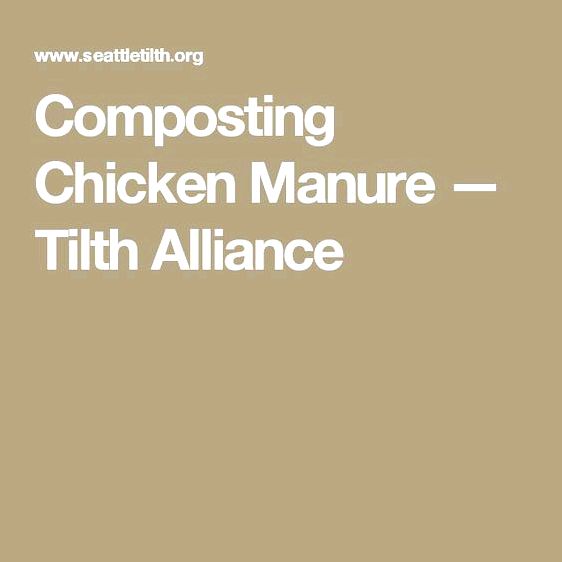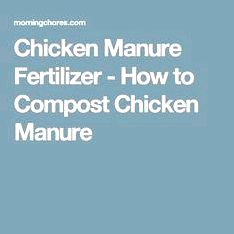Navigation article:

Chickens Produce Eggs and Manure
Your chicken produces an egg every 24 hrs which is wonderful to possess your own house-created fresh eggs. Your average size hen also produces 1 cubic feet of manure every six several weeks. What’s happening with this particular? Manure simply can’t still accumulate inside your coop. It stinks, attracts rodents and flies, and also the ammonia isn’t healthy for the chickens to breath.
Advantages of Chicken Manure
Don’t despair manure may be one of the finest assets for any home gardener! Although chicken manure is simply too strong for use raw in your flowers or vegetables, it may be composted and transformed into “black gold”. If used without composting it might damage roots and perhaps kill your plants, however, once it’s composted chicken manure is:
- A great soil amendment, chicken manure adds organic matter and boosts the water holding capacity and advantageous biota in soil.
- A great fertilizer chicken manure provides Nitrogen, Phosphorus and Potassium for you plants (greater than horse, cow or steer manure).
Composting Chicken Manure
If you’re not acquainted with composting and should try to learn how, contact the San antonio Tilth Garden Hotline at 206-633-0224. Hotline staff provides you with details about the constituents of composting: Carbon (browns – your coop bedding), Nitrogen (vegetables – your chicken manure), air, moisture, volume, and temperature. Here are a few recommendations to help you get began using chicken manure inside your compost pile:
- Collect manure and bedding. Chicken proprietors normally use bedding for example shavings, sawdust, dry leaves, or straw to supply a dry cushion for chickens and also to control odor and unwanted pests. The coop bedding could be collected using the manure and dumped right into a composting bin. Some proprietors choose to pick manure and soiled bedding from the coop every day others will prove to add new bedding over waste and collect on the more uncommon basis.
- Carbon to Nitrogen balance. A mix of 30 parts Carbon to at least one part Nitrogen produces the ideal atmosphere for microbes to interrupt lower organic material to create compost. When mixing coop bedding and chicken manure how can you attain the ideal C: N ratio? Because the different beddings their very own C: N ratio, the proportion of bedding to manure will be different with respect to the kind of bedding used. To help keep things simple most composters stick to the general rule of just one part brown to two parts eco-friendly. However, because chicken manure is really full of Nitrogen you might be more effective utilizing a 1:1 or perhaps a 2:1 mixture.
- Make use of a “hot compost” recipe. By mixing the right ratio of bedding and manure previously to create a pile, roughly one cubic yard, then adding moisture (material ought to be about as wet like a well squeezed sponge), will create a hot pile. It’s suggest that the compost pile heat to 130-150 levels F and keep that temperature for several days. Heating is essential to eliminate pathogens but temperatures above 160 levels F can kill advantageous microorganisms and slow the procedure. That will help you achieve appropriate temperature you can buy a compost temperature gauge from the local nursery.
- Repeat the heating process. Once the middle of your compost pile has arrived at the needed temperature for 3 days it will begin to awesome. After it cools, pull the middle apart and slowly move the core material towards the edges and produce the advantage material in to the center to heat. For 1 cubic yard of fabric do this again of getting edges in to the core a minimum of 3 occasions.
- Allow it to cure. Monitor the pile and when you are satisfied the entire items in your bin continues to be heated, loosely cover and let remedy for 45-two months before using. It’s ready when most materials are dark, crumbly and sweet-smelling like soil.
- Increase garden. You can include the resulting compost for your vegetable garden or garden by distributing it at first glance or by lightly working it into existing soil.
- Composting challenges. Does your compost pile stink, never decompose, or attract unwanted pests? Get advice in the San antonio Tilth Garden Hotline at 206-633-0224.
Compost Bin
Your bin ought to be a minimum of 1 cubic yard in dimensions (3x3x3 ft). If at all possible, it is recommended that you utilize a couple-bin compost system. One bin come in the new compost phase and yet another come in the curing phase. You may even require a storage site for that carbon materials you collect. This is often a 3rd bin or it may you need to be a stack of leaves or bags of shavings kept in a dry area. If you wish to add grass clippings or weeds for your bin, additionally, you will require a storage site with this material. The San antonio Tilth or WSU websites the following under Sources provide plans for creating a backyard compost bin.
Manure Safety Tips
Fresh chicken manure could have disease microorganisms that may contaminate root crops (carrots, radishes, beets) leaving (lettuce, green spinach), so NOT spread uncomposted manure around the soil inside your vegetable garden. The next “Safety Tips” are summarized in the Stewardship Gardening Program supplied by Washington Condition College:
- Apply only aged or composted manure for your soil.
- Always put on mitts when handling animals manure.
- Completely wash raw vegetables before eating.
- Don’t use cat, dog or pig manure in compost piles.
- Those who are prone to food borne illnesses should do not eat uncooked vegetables from manured gardens. Individuals who face risks from food borne illness include women that are pregnant, very youthful children, and persons with cancer, kidney failure, liver disease, diabetes or AIDS.

Have a Class
Dig much deeper! Join certainly one of San antonio Tilth’s Urban Animals or Permaculture classes to understand more about city chickens and composting.
Sources
- Soils, Compost and Mulch. WSU Cooperative Extension.
- Techniques for Animals Manure Management. WSU Cooperative Extension. King County, Agriculture and Natural Sources. Booklet #539.
- The San antonio Tilth 3-Bin Yard Waste Composter plans.
- The San antonio Tilth Garden Hotline is 206-633-0224.
___________________________________
Published by Judy Duncan, WSU Cooperative Extension, King County Master Gardener and Cooperative Extension Animals Consultant. Fall, 2005.
Resourse: http://seattletilth.org/learn/sources-1/city-chickens/
How Long Does It Take For Chicken Manure To Compost?
Tags: chicken, composting, manure, tilth
Comments are closed here.
